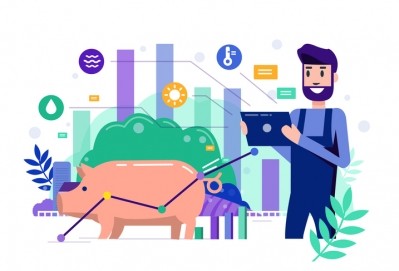AgGateway steps up efforts to track feed grains from farm to elevator

AgGateway is a business association comprised of a group of more than 230 agribusinesses involved in creating standards and implementation guidelines for the agriculture and feed industry. The group’s focus is to support the sector in moving towards digital agriculture and to increase use the use of technology, e-connectivity and information to improve productivity and efficiency in agribusiness.
“There are correlations as-planted, as-applied, and as-harvested Big Data enabling the industry to understand how to mitigate risk in the supply chain. More and more people that want to know where their food came from,” Scott Nieman, enterprise integration architect with Land O’Lakes, told FeedNavigator, talking about the overall project.
The group’s Commodity Automation by Rail and Truck (CART) project is an effort to make grain traceable from field to fork by using new standards or by improving existing ones.
The initiative is now seeking more participants for the project’s next proof-of-concept addressing commodity movement integration program. Interested participants may apply through to January 23.
The organization said this latest call for participation will build on the 2014 and 2017 proof of concept (PoC) efforts related to commodity transfer from source container to target containers, duration of the transfer, and method of the transfer.
The goal of the 2018 proof of concept phase of the project is:
- Efficiency improvements in the grain receiving process as a result of the receipt of shipment information into the respective business application(s) prior to the physical arrival of the grain,
- Ability to review weights and grade of a specific shipment prior to arrival, as well has last load (what) and relate container cleaning event (who, when, how).
- Automatic identification of grain transport containers upon the arrival of the shipment using Bluetooth low energy (BLE) beacons or RFID identification, with the potential of immediate retrieval of the shipment information.
- Enabling identification of grain elevator/processor load out bin into each shipping container (e.g., rail car or semi-trailer), enabling the traceability goals of the Food Safety Modernization Act (FSMA).
- Elimination of paper documents and file cabinets as warranted.
The AgGateway standards for grain tracking team reported a successful outcome to a field trial they ran last November on an Illinois corn farm. The trial was a major step forward in enabling the efficient tracking of harvested grain – from harvester to grain cart, grain cart to truck, truck to elevator, and elevator to processor, they said.
The team is now working to refine the standards based on the field test, and plans to finalize them this year.
Nieman explained the group is looking to develop the software and beacons needed to link information as grain leaves the field, or initial holding facilities, and goes to the grain elevator and then moves from a grain elevator to the next destination.
“What we’re hoping to do is build-up solutions that allow us to capture the necessary data,” he said. "We are answering the questions; what was the source container and target container, when the did the transfer start and end, what was the commodity, and how it was transferred and all that. Open source tools will build up these ‘transfer event’ payloads and send them from the devices to software applications used by the growers, co-operative grain elevator, and feed manufacturers like Purina Animal Nutrition.”
The group is now set to work with IT providers and several state universities on the technology required, said Nieman. The current plan is to use a BLE beacon that pairs with a device to connect the semi-trailer’s load of grain with the pit or bin where it is offloaded.
The challenge at this point is with the logistical side or the accounting process, as when tracking grain shipments a lot of paper records tend to be generated.
“We want to eliminate all the filing cabinets and speed up the receiving process.”
Eventually, mobile apps are set to be designed to keep those involved in the grain transfer process apprised of the grain information. A similar process would be used to track grain picked up at an elevator or storage site before it is delivered to a location where it would be used, like a Purina facility, said Nieman.
One goal would be to have data such as moisture level generated on the grain available prior to its physical arrival at the end user, he said.
“We’re interested in capturing loadout information and bin information,” he said. “The rest of it is internal to the grain elevators.”
The AgGateway working group is now looking to meet in February and March with the goal of having some of the practice testing in place by the mid-year meeting in June, he said.
Inside the elevator
The organization is now establishing a new working group that will, among other initiatives, look to publish industry recommendations for software usage to track grain movement within grain elevators.
There has been a mixed reaction from grain elevators at this point regarding efforts to better track received grain through internal actions like drying and blending, said Nieman.
“Some people [say] ‘This is the way we’ve always done it,’ and others are more innovative,” he said. “Some are seeing that grain separation is inevitable.”
In its engagement efforts with a few grain elevators, the standards design team found that they already have technology in place that would be able to track aspects of grain handling but they have not been using those features, he said. “Those are the decisions that we’ll have to help them understand,” he added.
The group also is set to visit a facility dedicated to work with certified non-gmo feed grains later this year, he said.













